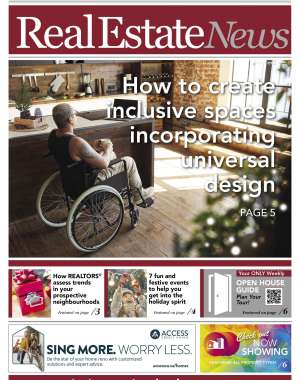This Sunday, December 3, is International Day of Persons with Disabilities, so it’s a perfect time to talk about accessability and universal design.
Encompassing everything from the building of a home itself to furnishings to finishing touches and more, universal design addresses the entire spectrum of needs for anyone who lives in and uses a space. According to StatsCan, one in five (22%) Canadians aged 15 years and older — or about 6.2 million individuals — have one or more physical disabilities. Those with one type of disability stood at 29% and those with two or more types stood at 71%.
The majority of us know at least one person with a disability and have seen how most of the environments around them aren’t always easy to interact with. As we ourselves age, the chances of the rest of us developing a disability that affects our mobility, vision or hearing increases in likelihood.
Instead of renovating to make spaces accessible, Universal Design offers an opportunity to make inclusive spaces that allow everyone to be a part of their community and live to their fullest potential.
Designing accessible spaces that are convenient for everyone also provides more housing options for individuals with mobility issues, enabling us to age in place, remain independent, and stay in our homes longer. This also enables access and function for all people regardless of size, shape, ability or disability.
Plan today for future needs
Even if you’re young and healthy, it’s a good idea to keep universal design at top of mind.
A recent survey by the CMA and National Institute of Ageing found that 96% of Canadians of all ages, and almost 100 per cent of Canadians 65 years of age and older, want to age at home and live independently for as long as possible — and do everything possible to avoid going into long-term care.
You may not see the need now, but with Universal Design, you’ll still be able to enjoy your space whether you need crutches for just a few weeks or a walker every day. This makes aging in place seamless. Universal Design principles ensure that homes are accessible to all while also increasing the appeal of a home that’s for sale and expanding the pool of potential buyers.
Incorporating universal design features
Accessibility features are considered to be ergonomic enhancements for everyone, not just those with special needs or mobility issues. There are plenty of simple, affordable ways to introduce accessible elements into your home. Installing lever handles instead of doorknobs will reduce the effort needed to open doors, while bright task lighting under your kitchen cabinets allows you to see better when preparing food.
In your design plans, ask for wider doors that a wheelchair can fit through. For multi-level homes, you can request that your closets are stacked one on top of each other in the building stage which would allow for an elevator in the future. Or make the staircases a bit wider to accommodate a chair lift. In the walk-in shower, add a bench that will make it easier to get in and out while minimizing the risk of falling. Solid grab bars in the bathroom also reduce the risk of injury on slippery floors and make getting out of the bathtub much easier. A vanity with an open space below the countertop at one end leaves lots of space for a wheelchair. A lowered section of a kitchen island with space below accommodates a wheelchair in the same way.
Other options to consider:
• Non-slip flooring for more confident mobility.
• Windows with low sills so those in wheelchairs can see outside.
• A bench or ledge both inside and outside so you can set things down to open and close a door.
• Installing smart home hubs in all areas of the house so those with limited mobility can be more independent.
• Locate a full bathroom — including the shower and tub — on the main floor.
• Place the laundry room on the same floor as the main living areas.
• Purchase front-loading laundry machines.
• Use railings for balconies and decks that don’t block the view while seated, such as those with tempered glass inserts.
There are also ways you can make your home more accessible for guests who are experiencing mobility issues. Temporary wheelchair ramps are available and fold up nicely for storage. Adhesive or suction grab bars for the shower are a great option if someone is staying overnight and you don’t want to drill into your tiles. If you’re unsure how to make your home accessible for visitors who may need it, just ask them what they’d benefit from! They’ll be happy to let you know.
The Universal Design Network of Canada website at universaldesign.ca offers many great resources for the built environment all the way to the virtual. You’ll find excellent tips here on how to plan for and incorporate universal design elements into your home.
While house-hunting, ask your REALTOR® to include properties that are visitable — those that either have universal design features already in place — or those that can be easily adapted to include accessible options in the future. REALTORS® can advocate for clients with permanent or temporary disabilities during the home buying or selling process, and during the home building process. In fact, incorporating Universal Design during the building process is more cost effective compared to renovating a home to make it accessible later on.
Together, you and your REALTOR® can find the perfect home to best fit all the stages of your life.



